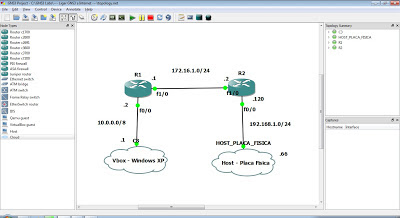1) Configuração inicial de rede em todos os routers do lab:
SSH(config): interface fastethernet 0/0
SSH(config-if): no shutdown
SSH(config-if): ip address 192.168.123.1 255.255.255.0
WEB(config): interface fastethernet 0/0
WEB(config-if): no shutdown
WEB(config-if): ip address 192.168.123.2 255.255.255.0
R3(config): interface fastethernet 0/0
R3(config-if): no shutdown
R3(config-if): ip address 192.168.123.3 255.255.255.0
R3(config): interface fastethernet 1/0
R3(config-if): no shutdown
R3(config-if): ip address 192.168.34.3 255.255.255.0
R4(config): interface fastethernet 0/0
R4(config-if): no shutdown
R4(config-if): ip address 192.168.34.4 255.255.255.0
2) Desactivação de funcionalidades de Router em WEB e SSH, para simular servidores:
WEB(config): no ip routing
WEB(config): ip default-gateway 192.168.123.3
SSH(config): no ip routing
SSH(config): ip default-gateway 192.168.123.3
3) Configuração de roteamento no R3 e R4:
R3(config): ip route 0.0.0.0 0.0.0.0 192.168.34.4
R4(config): ip route 192.168.123.0 255.255.255.0 192.168.34.3
4) Configuração de acesso total por telnet em WEB e SSH (não recomendado em ambientes de produção):
WEB(config): line vty 0 4
WEB(config-line): privilege level 15
SSH(config): line vty 0 4
SSH(config-line): privilege level 15
5) Configuração de NAT no R3:
R3(config): interface fastethernet 0/0
R3(config-if): ip nat inside
R3(config-if): exit
R3(config): interface fastethernet 1/0
R3(config-if): ip nat outside
R3(config-if): exit
6) Abertura das porta 80 no WEB e 22 no SSH:
WEB(config): ip http server
SSH(config): ip domain-name LAB.LOCAL
SSH(config): crypto key generate rsa
SSH(config): line vty 0 4
SSH(config-line): transport input ssh
7) Configuração de "Port Forwarding" nas portas 80 e 22 para o WEB e SSH respectivamente:
R3(config): ip nat inside source static tcp 192.168.123.2 80 192.168.34.3 80
R3(config): ip nat inside source static tcp 192.168.123.1 22 192.168.34.3 22
8) Testar o acesso por telnet no R4:
telnet 192.168.34.3 80
telnet 192.168.34.3 22
O resultado será o seguinte:
9) Enquanto a ligação telnet está aberta testar no WEB:
WEB# show ip http server connection










